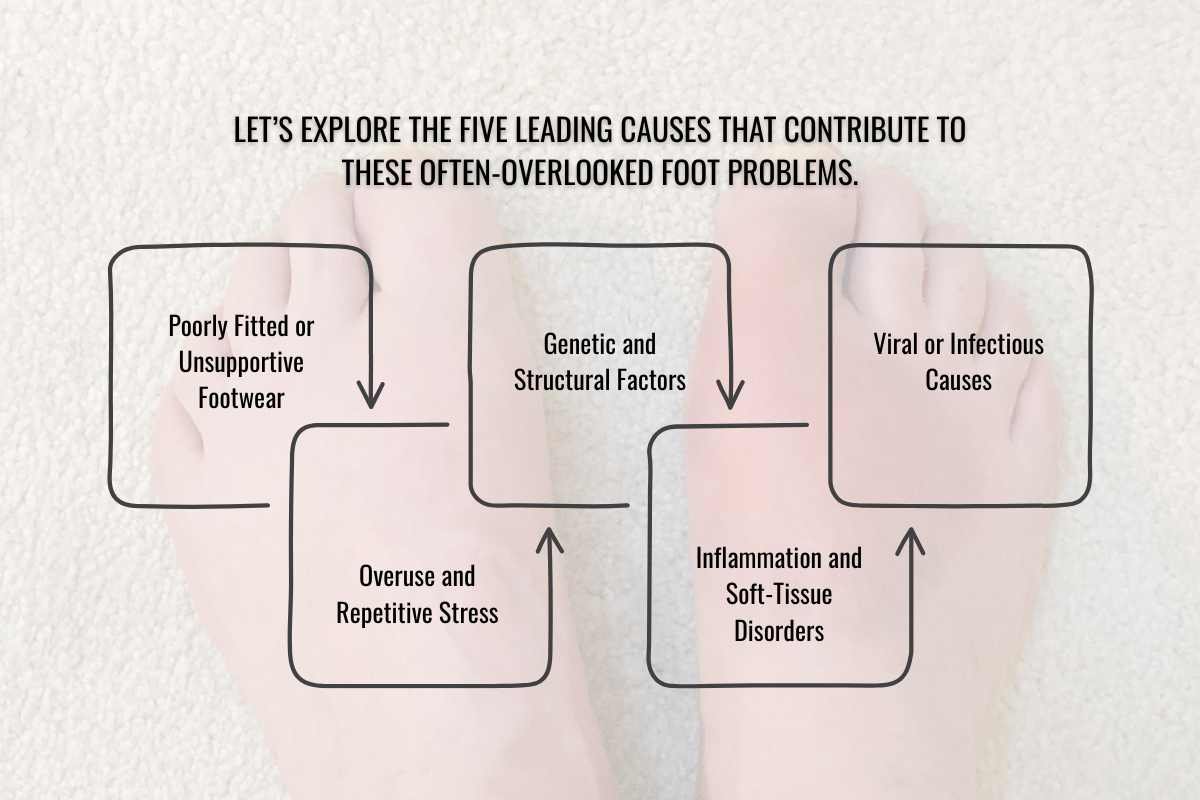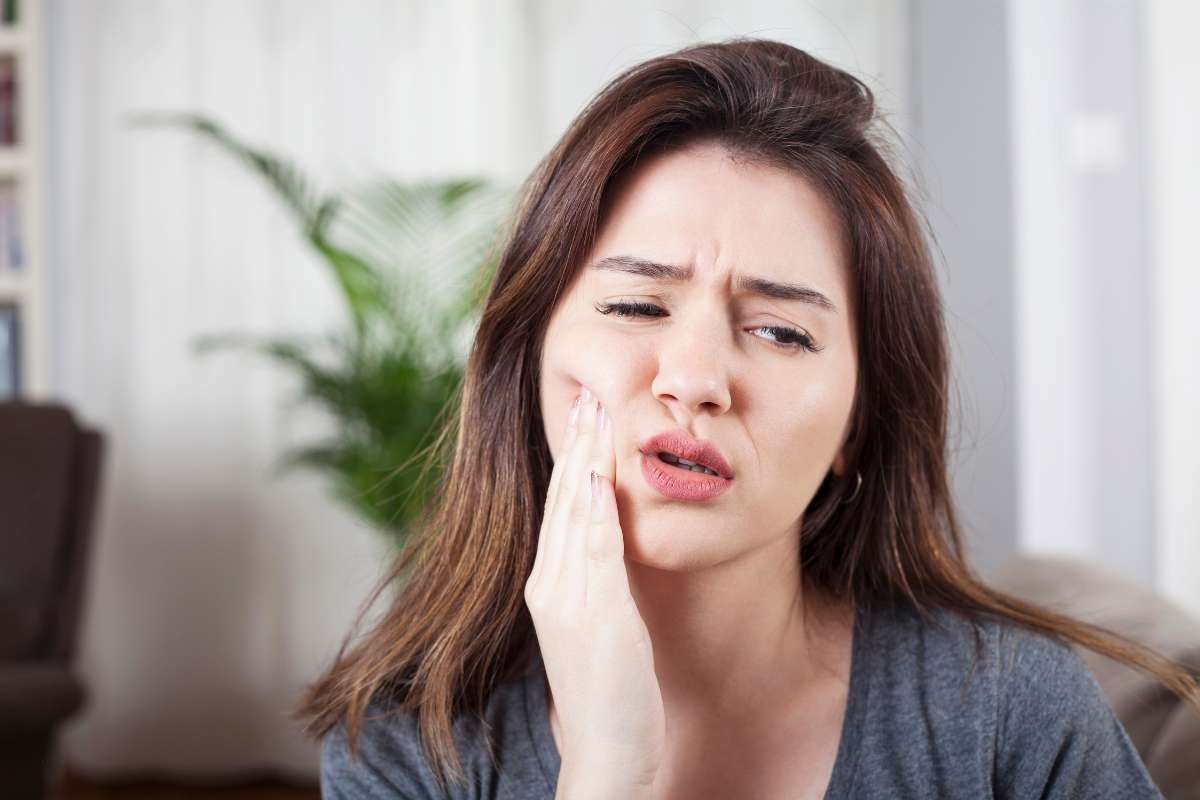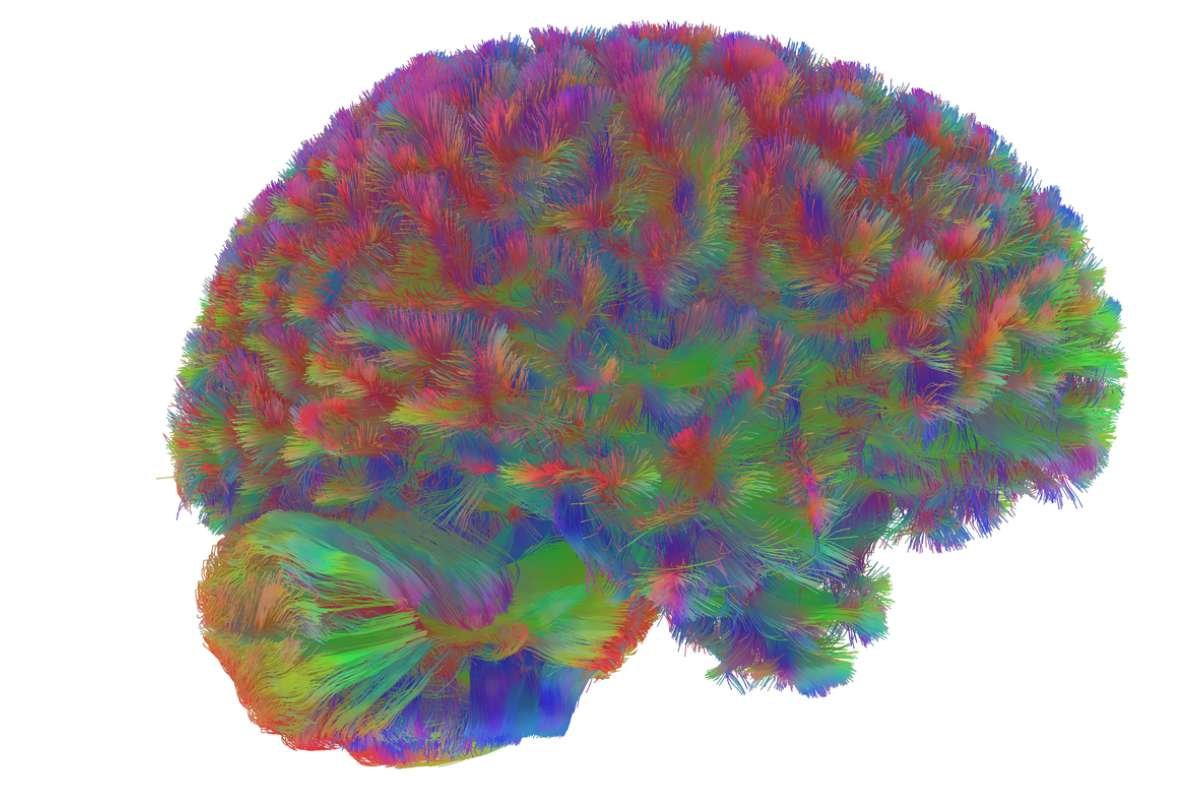You take 8,000 to 10,000 steps a day, but how often do you think about your feet? They quietly carry you through morning jogs, busy workdays, and late-night errands. But the moment you notice a bump, lump, or thickened patch of skin, that simple step suddenly feels different.
Don’t worry, you’re not alone. The APMA says nearly 8 in 10 adults experience foot pain or abnormalities, many caused by common foot bumps and lumps. These can appear as soft nodules, bony protrusions, or fluid-filled sacs, sometimes painless, sometimes persistent, but always worth understanding.
Since your feet absorb massive pressure daily, factors like tight shoes, long standing hours, or genetics can easily trigger Common Lumps and Bumps on the Foot. Most are harmless, but some signal issues like tendon inflammation or nerve compression.
In this blog, we’ll walk you through the most common types, what causes them, how to spot them, and what treatments actually help so you can move forward with clarity, comfort, and healthier feet.
What Are Common Foot Bumps and Lumps?
Before you can treat them, it’s important to understand what common lumps and bumps on the foot actually are. In simple terms, these are abnormal swellings or protrusions that form on or beneath the skin of your foot. They might feel soft, hard, painful, or even completely painless, depending on what’s causing them.
Think of your foot as an intricate structure made up of 26 bones, 33 joints, and more than 100 muscles, tendons, and ligaments. It’s no surprise that any one of these components can be affected by pressure, friction, or inflammation, leading to the formation of a bump or lump. Some may be caused by bone misalignment or extra bone growth (like bunions or Haglund’s deformity), while others form due to soft-tissue changes, such as cysts, fibromas, or warts.
In most cases, these common foot bumps and lumps develop gradually, starting small and becoming more noticeable over time. The location and texture can tell a lot about their nature:
- Bony lumps near the toes or heel often suggest structural issues or deformities.
- Soft, movable bumps may indicate fatty growths or fluid-filled sacs.
- Rough, raised patches are commonly linked to calluses or plantar warts.
Understanding the difference between these types is key to getting the right diagnosis. For example, what looks like a harmless callus could actually be a sign of plantar fibroma or Morton’s neuroma, both of which need medical care.
Experts from the University Foot & Ankle Institute emphasize that identifying the type and cause of the bump early can prevent long-term complications, especially for people with diabetes, arthritis, or chronic foot strain. Left untreated, even minor lumps can alter the way you walk, leading to further joint or tendon issues.
So, while some common lumps and bumps on the foot are harmless reminders of daily wear and tear, others serve as subtle warning signs that something deeper may be going on. The next section breaks down the most common types, how they form, and the best ways to manage them so you can tell which ones deserve a closer look and which can be handled with simple care.
Top Categories of Common Foot Bumps and Lumps
Now that you understand what’s happening beneath the surface, let’s explore the most frequent types of common lumps and bumps on the foot, how they form, how they feel, and what you can do about them. Every bump tells a story, whether it’s your body’s natural defense mechanism or a signal to pay closer attention to your foot health.

1. Calluses: The Body’s Natural Armor
| Common Location | Ball of foot, heel, or toes |
| Treatment Options | Foot soaks, pumice stone, cushioned insoles, moisturizing creams |
Calluses are among the most common skin-related changes on the feet, thick, rough patches that develop where friction and pressure are constant. Think of them as your body’s natural armor. They usually appear on the heels, balls of the feet, or tops of the toes, especially for those who walk or stand for long periods.
Over time, calluses can grow hard, crack, or even cause pain when walking. Although they may seem harmless, neglecting them can lead to infection or an imbalance in foot posture. Regular exfoliation, proper footwear, and moisturizing help prevent buildup, but if your callus becomes painful or deep, it’s best to see a podiatrist for safe removal.
2. Bunions: When the Big Toe Tells a Bigger Story
| Common Location | Base of the big toe |
| Treatment Options | Orthotics, padding, wide-toe shoes, and corrective surgery if severe |
Among common foot bumps and lumps, bunions are one of the most recognizable and frustrating. This bony bump forms at the base of your big toe when the joint shifts out of alignment, a slow, painful process often linked to genetics, flat feet, or years of tight-fitting shoes.
At first, it may just look like a slight swelling. But over time, the bump can become red, tender, and even push the second toe inward, changing the shape of your foot. Start early. Switch to wide-toe shoes, use cushioning pads, and perform gentle foot exercises. Severe cases may need corrective surgery, but addressing bunions in their early stages can prevent long-term discomfort and deformity.
3. Plantar Fibroma: The Arch’s Silent Bump
| Common Location | Arch of the foot |
| Treatment Options | Custom orthotics, physical therapy, corticosteroid injections, and surgery in chronic cases |
Imagine feeling a firm lump right in the middle of your foot’s arch; that’s the telltale sign of a plantar fibroma. This benign tissue growth forms within the plantar fascia, the strong band that supports your foot. While small fibromas often go unnoticed, larger ones can make every step feel like walking on a pebble.
Experts suggest genetics, minor injuries, and repetitive strain as possible triggers. Soft orthotics or custom insoles can redistribute pressure, while injections may shrink the lump. Surgery is typically a last resort for persistent pain.
4. Accessory Navicular Syndrome: The Hidden Extra Bone
| Common Location | Inner side of the midfoot |
| Treatment Options | Arch supports, immobilization, physical therapy, or surgical removal if persistent. |
Few people realize that about 10%-14% of the population has an extra bone on the inner side of their foot called an accessory navicular. For most, it goes unnoticed. But when this extra bone becomes irritated, it transforms into one of the more painful common foot bumps and lumps, known as Accessory Navicular Syndrome.
It often appears as a firm bump above the arch, accompanied by redness and tenderness, especially after physical activity or tight footwear. Rest, anti-inflammatory medication, supportive arch straps, and custom orthotics can help. In chronic cases, surgical removal of the accessory bone offers long-term relief and restores balance.
5. Morton’s Neuroma: The Invisible Agony Between Toes
| Common Location | Between 3rd and 4th toes |
| Treatment Options | Orthotic inserts, corticosteroid injections, and surgery if chronic |
Unlike other lumps you can see or touch, Morton’s neuroma hides between your toes. It occurs when a nerve between the third and fourth toes becomes compressed or thickened, causing a sharp, burning pain that feels like you’re walking on a small stone.
It’s particularly common among runners or those who frequently wear high heels. Switching to supportive shoes, using metatarsal pads, and reducing repetitive stress can ease symptoms. Persistent cases may benefit from corticosteroid injections or surgical decompression.
6. Plantar Warts: The Stubborn Side of common lumps and bumps on the foot
| Common Location | Soles or heels |
| Treatment Options | Cryotherapy, salicylic acid treatment, and laser removal |
Don’t let their small size fool you, plantar warts are one of the most stubborn common lumps and bumps on the foot out there. Caused by the human papillomavirus (HPV), these growths thrive in warm, moist environments like gym floors and locker rooms.
They often appear as flat, grainy lesions with tiny black dots (clotted capillaries) and can be painful when pressure is applied. Because plantar warts can spread easily, early treatment is key. Cryotherapy (freezing), salicylic acid, or laser therapy under professional care. For prevention, always wear flip-flops in public showers and keep your feet dry.
7. Lipoma: A Gentle but Noticeable Visitor
| Common Location | Top or side of the foot |
| Treatment Options | Monitoring, surgical removal if large or painful |
Soft, squishy, and slow-growing, a lipoma is a benign fatty lump that develops beneath the skin, often on the soles or sides of the foot. Although usually painless, it can cause discomfort if it presses on nerves or tendons.
Lipomas are harmless but can sometimes be mistaken for cysts or other soft-tissue masses. Monitoring is enough for small ones; surgical removal may be needed if pain or size increases.
8. Haglund’s Deformity: The Heel’s Hidden Trouble
| Common Location | Back of heel |
| Treatment Options | Heel pads, shoe modification, anti-inflammatory medication, and surgery in severe cases |
Known as the “pump bump”, Haglund’s deformity is a bony enlargement on the back of the heel that develops from constant friction often caused by stiff shoes or heels. It’s one of those common lumps and bumps on the foot that can turn minor irritation into chronic discomfort if left untreated.
The bump may swell, redden, or even rub against the Achilles tendon, making walking or running painful. Ditch rigid footwear, use heel cushions, and apply ice to reduce inflammation. In persistent cases, a podiatrist may recommend physical therapy or, rarely, surgery to reshape the heel bone.
9. Foot Bursitis: When Cushioning Turns Against You
| Common Location | Heel or ball of the foot |
| Treatment Options | Rest, ice therapy, physiotherapy, orthotic support |
Bursae are small, fluid-filled sacs that cushion your joints, but when they become inflamed, they create painful swelling around the toes, heel, or ball of the foot. This inflammation, known as foot bursitis, often feels like a soft lump that hurts when pressure is applied.
Common causes include overuse, ill-fitting shoes, or repetitive stress. Rest, anti-inflammatory medications, and improved footwear can usually bring relief within weeks.
10. Ganglion Cysts: The Mysterious Bubbles Among Common Foot Bumps and Lumps
| Common Location | Top of the foot or ankle |
| Treatment Options | Aspiration, shoe modification, and surgical removal if recurrent |
Among all common lumps and bumps on the foot, ganglion cysts are perhaps the most mysterious. These jelly-like sacs filled with synovial fluid typically appear near tendons or joints, often on the top of the foot or around the ankle.
They can fluctuate in size, sometimes shrinking on their own and other times becoming large enough to cause discomfort or restrict movement. Observation is fine for painless cysts. For recurring or painful ones, your podiatrist may drain the fluid or surgically remove the cyst to prevent it from returning.
Every one of these common lumps and bumps on the foot reveals how much your feet endure daily. Some are simply reminders of overuse, while others serve as warning signs of deeper biomechanical issues. In the next section, we’ll explore when it’s time to see a specialist because knowing when to act can make all the difference between quick recovery and long-term discomfort.
Read Next:
- Understanding Bone Spurs on Feet: Causes, Symptoms, Treatment, and Prevention
- What’s Inside Your Lower Leg? Learn about Tibia and Fibula Anatomy with Labeled Diagram
Top 5 Causes Behind Common Foot Bumps and Lumps
Our feet endure more impact and stress than almost any other part of the body, taking an average of 8,000 to 10,000 steps per day. Over time, that repeated strain can trigger tissue damage, inflammation, or bone misalignment, resulting in common lumps and bumps on the foot. But while overuse is one major factor, it’s far from the only one.
Comparison Table: Common Causes and Their Typical Outcomes
| Cause | Examples of Related Conditions | Primary Effect | Preventive Tip |
| Poor Footwear | Bunions, Corns, Morton’s Neuroma | Bone misalignment, nerve compression | Wear wide-toe, cushioned shoes |
| Overuse & Stress | Plantar Fibroma, Haglund’s Deformity | Tissue strain and swelling | Alternate activities, add rest days |
| Genetic Factors | Flat feet, Accessory Navicular | Structural imbalance | Supportive insoles, early screening |
| Inflammation | Bursitis, Ganglion Cysts | Fluid buildup and pain | Ice therapy, anti-inflammatory care |
| Viral Infection | Plantar Warts | Skin thickening, pain | Keep feet clean and dry; use shower shoes |
Let’s Explore the Five Leading Causes That Contribute to These Often-overlooked Foot Problems

1. Poorly Fitted or Unsupportive Footwear
One of the biggest culprits behind common lumps and bumps on the foot is footwear that doesn’t properly support the foot’s natural structure. High heels, narrow shoes, or stiff materials can push the toes into unnatural positions, causing bunions, corns, or nerve compressions like Morton’s neuroma.
Fact: According to a study by the American Orthopaedic Foot & Ankle Society, 88% of women wear shoes that are too small, and more than half of them develop chronic foot deformities. Over time, the constant friction and pressure lead to hard skin layers, bone protrusions, and even cyst formation.
2. Overuse band Repetitive Stress
Athletes, runners, and individuals with active jobs are especially prone to common foot bumps and lumps caused by repetitive impact. Conditions like plantar fibroma and Haglund’s deformity develop when the tendons and ligaments are overworked or overstretched.
When the soft tissues fail to recover fully between activities, microtears form, leading to inflammation and eventual lump formation. Even everyday activities like long walks or standing for extended hours can trigger similar outcomes.
3. Genetic and Structural Factors
For many people, common lumps and bumps on the foot aren’t just about lifestyle; they’re hereditary. If you have a family history of flat feet, high arches, or bunions, you’re genetically predisposed to certain foot deformities. Structural misalignments can cause uneven weight distribution, making one part of the foot more vulnerable to pressure-induced growths or swelling.
Example: The Accessory Navicular Syndrome often runs in families and tends to appear during adolescence or early adulthood.
4. Inflammation and Soft-Tissue Disorders
Conditions like bursitis, ganglion cysts, and lipomas often stem from chronic inflammation or tissue irritation. These common foot bumps and lumps can form when the body overproduces fluid or scar tissue to protect an irritated area.
Inflammation may be caused by arthritis, autoimmune conditions, or even repeated minor injuries. In some cases, these lumps are your body’s way of cushioning stress points, but if ignored, they can harden or become painful.
5. Viral or Infectious Causes
Not all common lumps and bumps on the foot originate from mechanical issues; some come from infections. Plantar warts, for instance, are caused by the human papillomavirus (HPV), which enters through small cuts or cracks in the skin.
Public showers, gyms, and swimming pools are hotspots for this virus. Because the skin on the soles is thick, these warts grow inward, causing pain while walking. Early treatment is essential to prevent spreading to other areas of the foot.
How to Diagnose and Treat Common Foot Bumps and Lumps?
If you’ve noticed a strange bump on your foot, you’re not alone. Studies suggest that nearly 70% of adults experience a form of foot lump or swelling at some point in their lives. The good news is that most common lumps and bumps on the foot are benign and treatable. However, understanding what you’re dealing with and how to manage it properly can make all the difference between short-term relief and lasting comfort.
1. Getting the Right Diagnosis
Before jumping into treatment, identifying the exact cause of the bump is crucial. Many conditions look similar but differ vastly in origin; for example, a plantar fibroma might resemble a cyst, but their treatments differ.
Here’s how foot specialists typically diagnose common lumps and bumps on the foot:
- Physical Examination: The podiatrist checks for size, shape, texture, mobility, and pain response.
- Imaging Tests:
- X-rays reveal bone deformities like bunions or spurs.
- MRI or Ultrasound helps detect soft-tissue issues like fibromas, cysts, or neuromas.
- Biopsy or Fluid Sampling: Rarely, a tissue sample is analyzed to rule out infections or abnormal growths.
Early evaluation is key, especially if you notice rapid growth, discoloration, numbness, or persistent pain in the affected area.
2. Conservative (Non-Surgical) Treatments

Most common foot bumps and lumps respond well to non-invasive methods aimed at reducing pressure and inflammation. These are usually the first line of care before considering surgery.
Popular Non-Surgical Approaches Include:
- Custom Orthotics: Redistribute pressure evenly across the foot to prevent stress on affected areas.
- Ice Therapy: Reduces swelling and inflammation, especially for bursitis or fibroma.
- Anti-Inflammatory Medications: Help ease discomfort from arthritis or soft-tissue irritation.
- Foot Soaks and Moisturizers: Ideal for calluses or corns caused by dryness and friction.
- Padding or Protective Footwear: Reduces friction, especially for bunions and Haglund’s deformity.
These methods are typically recommended for mild to moderate cases, and consistent care can significantly reduce symptoms within weeks.
3. Advanced or Surgical Treatments
When conservative methods fail or pain persists, your podiatrist may recommend surgical correction. These procedures are often quick and highly effective when done early.
Surgical Options May Include:
- Excision Surgery: Removal of cysts, fibromas, or lipomas.
- Bunionectomy: Realignment of the big toe joint.
- Debridement or Wart Removal: For stubborn plantar warts.
Modern foot surgeries are minimally invasive, with short recovery times and high success rates, especially when combined with post-surgical physiotherapy.
Comparison Table: Diagnosis and Treatment Options
| Condition | Diagnosis Method | Primary Treatment | Recovery Time | When to See a Doctor |
| Bunions | Physical exam, X-ray | Orthotics, surgery | 2–6 weeks (post-surgery) | If pain affects daily movement |
| Plantar Fibroma | MRI, palpation | Physical therapy, orthotics | 3–6 weeks | If the lump enlarges or causes arch pain |
| Ganglion Cyst | Ultrasound, fluid test | Aspiration, removal | 1–2 weeks | If the cyst recurs or restricts motion |
| Plantar Warts | Visual exam | Cryotherapy, acid treatment | 1–3 weeks | If spreading or painful |
| Accessory Navicular | X-ray, MRI | Rest, immobilization, surgery | 4–8 weeks (if surgery) | If chronic arch pain persists |
| Haglund’s Deformity | X-ray | Heel pads, shoe modification | 2–4 weeks | If swelling becomes severe |
| Bursitis | Physical exam | Ice therapy, anti-inflammatories | 1–3 weeks | If redness or warmth develops |
| Morton’s Neuroma | MRI | Orthotic inserts, injections | 2–6 weeks | If burning pain spreads to the toes |
Self-Care Tips for Long-Term Relief
Even after treatment, daily habits play a huge role in preventing recurrence. Try incorporating these expert-approved steps into your routine:
- Switch Shoes Regularly: Avoid tight or high-heeled shoes for extended hours.
- Stretch Daily: Simple calf and arch stretches reduce tension and improve circulation.
- Moisturize and Inspect Feet: Especially vital for people with diabetes or circulation issues.
- Listen to Pain Signals: Persistent soreness is your body’s way of asking for rest or attention.
When to See a Doctor for Common Foot Bumps and Lumps?
While many foot bumps are harmless and manageable at home, certain symptoms should never be ignored. Foot specialists emphasize that early intervention can prevent long-term complications like nerve damage, joint misalignment, or chronic inflammation. Knowing when to seek medical care is just as important as understanding the bump itself.
Here are the key warning signs that indicate it’s time to consult a podiatrist or orthopedic specialist.
1. Persistent or Worsening Pain
Any bump that causes ongoing pain, especially when walking, standing, or wearing shoes, is a clear signal that something deeper may be at play. Pain that worsens over weeks often indicates conditions like plantar fibroma, bursitis, or Morton’s neuroma. Early medical consultation can prevent them from turning into debilitating issues that affect your daily mobility.
2. Rapid Growth or Visible Changes
Most common lumps and bumps on the foot grow slowly, if at all. A lump that suddenly increases in size, changes color, or becomes harder or warmer than usual should be evaluated promptly. These changes may suggest infection, aggressive inflammation, or, in rare cases, abnormal tissue growth that needs immediate attention.
3. Difficulty Walking or Bearing Weight
If a bump causes limping, imbalance, or pressure pain that affects your gait, it’s time to see a professional. Even conditions that initially seem minor, like calluses or warts, can interrupt natural movement, leading to knee, hip, or back strain due to altered posture.
4. Numbness, Tingling, or Burning Sensations
Neurological symptoms such as burning, tingling, or numbness in the foot may indicate nerve compression. Morton’s neuroma, ganglion cysts, or misaligned bones often compress nearby nerves, and delaying treatment can worsen the damage. Early evaluation helps prevent chronic neuropathy or long-term nerve irritation.
5. Signs of Infection
Redness, warmth, foul odor, pus, or unexplained swelling around the bump are classic infection indicators. This is especially important for people with diabetes, circulation disorders, or weakened immunity; even minor foot issues can escalate quickly and require medical treatment to avoid complications.
Prevention Tips: How to Protect Your Feet from Future Problems?
Preventing chronic foot pain isn’t just about treating a condition after it appears — it’s about understanding your body, recognizing early red flags, and taking small, consistent steps to protect your feet long-term. Foot structure, daily habits, and lifestyle choices all play a major role in whether you stay pain-free or eventually struggle with issues like tendon irritation, collapsed arches, or bone-related discomfort.
Below is a more detailed and descriptive version of this prevention section, along with a simple table summarizing key precautions.
1. Wear Proper Footwear Every Day
Choosing the right shoes is one of the easiest ways to prevent foot strain. Look for cushioning, arch support, and a stable heel counter. Avoid narrow-toed, flat, or unsupportive shoes, especially if you walk long distances or stand for work. The wrong footwear forces your tendons and ligaments to compensate, gradually creating imbalance.
2. Strengthen Your Arches and Ankles
Strong feet are stable feet. Exercises like towel scrunches, calf raises, and resistance-band ankle movements help improve alignment and reduce the risk of overpronation or instability. These strengthening routines keep the small muscles of your feet active and prevent them from getting overpowered by larger muscle groups.
3. Maintain a Healthy Body Weight
Excess weight puts disproportionate stress on the bones and tissues in your feet. Even a few extra kilograms can significantly increase pressure on your arches, heels, and ankles. Maintaining a balanced weight reduces repetitive strain and supports natural foot mechanics.
Table: Key Prevention Tips for Long-Term Foot Health
| Prevention Strategy | Why It Matters | How It Helps You |
| Wearing supportive footwear | Reduces pressure on arches & tendons | Maintains proper alignment and prevents chronic strain |
| Strengthening feet & ankle muscles | Improves stability and balance | Lowers the risk of tendon issues and collapse of the arch structure |
| Maintaining a healthy body weight | Reduces load on small foot bones | Prevents long-term stress and inflammation |
| Gradual increase in activity levels | Avoids sudden overload | Protects tendons, ligaments, and accessory bones |
| Responding to early symptoms | Prevents escalation of minor injuries | Helps avoid chronic pain or structural deformities |
Read Next:
- Understanding the Tibia and Fibula: The Dynamic Duo of the Lower Leg
- Demystifying Foot Bones Anatomy: A Comprehensive Exploration
Conclusion
Your feet do far more than support your body; they carry your life, step by step, day after day. And while bumps, lumps, and sudden changes can feel alarming, understanding them is often the first step toward relief. From harmless calluses to more complex conditions like Morton’s Neuroma or Accessory Navicular Syndrome, these issues are far more common than most people realize. What matters is recognizing the signs early, responding with the right care, and knowing when to seek professional help.
Ignoring foot discomfort may seem easy in the moment, but small symptoms can quickly grow into bigger problems. Whether it’s persistent swelling, a new bump, or pain that keeps returning, listening to your body is crucial. A podiatrist or foot and ankle specialist can diagnose the exact cause, offer targeted treatment, and help you prevent future complications.
The good news? Most common foot bumps and lumps are manageable, and many are fully treatable with the right combination of early diagnosis, proper footwear, simple lifestyle changes, and specialized care when needed. With attention, awareness, and timely intervention, you can stay active, mobile, and pain-free.
Your feet have supported you for years. This is your chance to support them back, one informed, confident step at a time.







